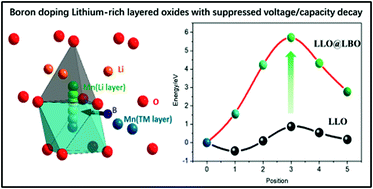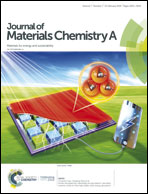Enhanced cycling stability of boron-doped lithium-rich layered oxide cathode materials by suppressing transition metal migration†
Abstract
Lithium-rich layered oxide (LLO) has been considered as an attractive candidate due to its high capacitive performance. However, its practical applications are hindered by voltage/capacity fading, low initial coulombic efficiency, and non-negligible Mn2+ dissolution. Herein, we have prepared boron-doped LLO (LLO@LBO) with excellent cycle/voltage retention and improved initial coulombic efficiency by a facile synthesis process. First-principles calculations and ex situ XRD have clarified that the incorporation of boron atoms in the tetrahedral interstices can effectively impede the migration channel of the transition metal ions. The strong B–O bonds can enhance the structural stability of LLO@LBO. Furthermore, the boron doping technique can suppress Mn2+ dissolution in LLO@LBO during cycling and improve the life time of the cathode and anode electrodes simultaneously. In the lithium ion battery cathode tests, the LLO@LBO delivers a reversible capacity of 293.9 mA h g−1 with a capacity retention of 89.5% at 0.5C after 100 cycles. The full cell test shows an initial energy density of 472.1 W h kg−1 with excellent energy retention of 84.1% after 150 cycles.



 Please wait while we load your content...
Please wait while we load your content...